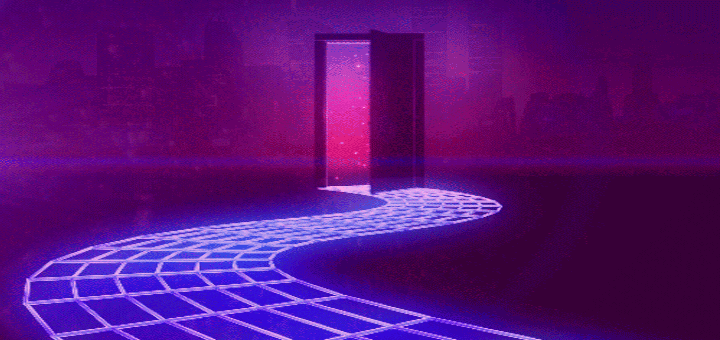 Vaporwave: a wtf moment
Vaporwave: a wtf moment
The A E S T H E T I C is a type of sound, not a type of music. It is the essential element of vaporwave. The music in vaporwave is not governed by melody, rhythm, or even good taste. None of this is to speak negatively of the genre, only to describe. The philosophy behind vaporwave is that it conveys an experience. It can be like sitting in a shopping mall listening to the general sounds: the repetitive pop music in clothing stores, the hustle and bustle of the food court, conversations, beeps, buzzes, and every other expression that comes with the mall aesthetic.[1]
Nostalgia is another factor. We can listen to albums devoted to producing vague recollections of childhood memories playing videogames. The electronic bass and synth sounds of the ‘80s, Funk sounds of the ‘70s or modern Japanese Funk, have been combined and modified to form the basis of Future Funk, a broad offshoot of vaporwave. In every instance, the listener feels reminiscent of the past. It is felt in an unusual way; the music itself is unfamiliar and yet the way it sounds triggers memories of a familiar aesthetic. It is familiar and unfamiliar. Despite the sounds often being unpleasant to the ears, there are endless volumes of vaporwave on the internet.
With a Google search, you can find websites devoted to hosting vaporwave artists. There are dedicated YouTube channels with millions of viewers. There are Spotify playlists that will tour you through the many varieties of vaporwave. It has a niche but loyal audience which has exploded in number over the past decade.
Where did it all begin?[2]
In the early 2010s, vaporwave began to form on platforms such as Tumblr and Reddit. The genre began quite literally as a joke created by Daniel Lopatin, under the pseudonym “Chuck Person”, with the release of the album Eccojams Vol 1. The artist chopped up and slowed down numerous 1980’s pop songs. Lopatin described his album as a joke or as something he created just for fun. Vaporwave became solidified as a genre following the release of the album Floral Shoppe, credited to the artist “Macintosh Plus”. The most famous track from this album is “リサフランク420 / 現代のコンピュー”, which translates to “Computing of Lisa Frank 420 // Contemporary”. It is a transformation of the Diana Ross hit single, “It’s Your Move”. On a superficial level, the song is nothing more than Diana Ross slowed down, however, its aesthetic expresses a deep artistic intent, evoking nostalgia and brooding complacency.
For a genre that began as a joke, a powerful creative force emerged on the internet. Artists across the globe began experimenting with the sound, producing unique styles and subgenres. Blank Banshee introduced Trap style electronic beats to the vaporwave style which gave the music a more robotic and cool aesthetic. Saint Pepsi introduced ‘70s funk sounds into the vaporwave genre with the album, “Hit Vibes”, which inspired the entire subgenre of Future Funk.
A Parody of Consumer Culture
There is a paradox to the music, which comes inherently from its history. On the one hand, vaporwave takes itself very seriously; it has rules and standards. There is a philosophy of nihilism and nostalgia that accompanies the music. The creation of the music itself is a mocking of pop culture through creating Frankenstein-like amalgamations of old pop music. The genre embraces the absurd, not unlike the Dada movement of the early 20th century. The artwork accompanying the music invariably features a combination the same few elements: pop consumer items such as Coke bottles, videogame paraphernalia, Roman sculptures & busts, Japanese letters and anime cartoons, 1980s neon wire frames and futurism, and tropical locales. These images are not hand drawn, animated, digitally painted, or generated using any other design tool; it resembles a collage of randomly taken images placed together to form a new image. They are a digital form of absurdist or Dada collage. Oftentimes, cryptic messages are implemented into the artwork. These mainly allude to the absurdity or nihilistic dimensions of human consciousness. This further supports the notion that there is a serious and deep meaning behind vaporwave. To illustrate, we see images with quotes such as “I can’t”, “where are you?”, “you left in peace, left me in pieces”, and “can I just disappear?”. All of these signify that the aesthetic of the genre is signifying a loss, a disenchantment with the present, and a bittersweet nostalgia.
Vaporwave must be heard to be understood. My goal has been to intrigue you, the reader, to look deeper into a relatively underground genre of “music”. The rabbit hole is deep, and after years of enjoying vaporwave, it always has something new in store for me.
[1] A subgenre of vaporwave, Mallsoft, intentionally evokes the shopping mall aesthetic. – Example:
[2] Vaporwave: A brief history https://www.youtube.com/watch?v=PdpP0mXOlWM
